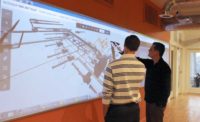
Fully appreciating the implications of design alternatives for a major structure can take a great deal of analysis and an even greater ability to visualize changes. One Rhode Island structural engineering firm finds the stakes high enough that it has developed its conference space into a 10-projector BIM immersion room for collaboration with as many as 40 people.
"We realized BIM could be supercharged by creating a room where the design and construction teams could be immersed in the models," says David J. Odeh, principal at Odeh Engineers, in Providence. The company has invested about $100,000 in the room over several years. Employees call it "the war room."
Odeh says the decision to create an immersion space was a natural fit for the firm, which has strived for "paperless" operations since its founding in 1981. It converted to 3D design in 2006.
The immersion room has 10 Sony VPL-FHZ55 laser projectors. Five are on the ceiling and five are mounted under the edge of the conference table. Each has a brightness of 4,000 lumens and a 20,000-hour light source. "Conventional LCD projectors fade over time—shades have to be closed, you can see the boundaries of the different projectors, and image quality degrades with distance of the projector to the wall," explains Odeh.
A single BOXX Technologies computer with three NVIDIA Quadro K5000 graphic cards runs the show. Software from Scalable Display Technologies delivers 18-megapixel images across the 32-ft-wide by 10-ft-tall projection surface, with no visible seams between images. The wall is coated with reflective paint designed for projections.
Odeh says the "five-over-five" configuration was chosen after considering rear projection, which they concluded takes up too much space, and using fewer projectors, which would have resulted in lower resolution and require farther distance from the screen for full coverage.
The room is 40 ft wide by 30 ft deep. The rear wall is lined with two-drawer, lateral filing cabinets whose bottom drawers are modified so they pull out to make "stadium style" seating.
Matt Guinan, senior project manager at contracting firm L.F. Driscoll, Bala Cynwyd, Pa., says the room served his team well on a project with Odeh during foundation work on a $100-million University of Pennsylvania Health System expansion project. "We needed to understand the implications of modifying the building shape after a steel mill order had already been placed," says Guinan.
The contracting team traveled to Providence with the fabricator, Steelfab, of Roanoke, Ala., for a meeting in the room.
Odeh's engineers "made revisions to the building on one screen while showing the lateral impact analysis to the structural steel shapes that we had already purchased on another," Guinan says.
"This let us make decisions about steel members that either needed to be replaced or could be reinforced due to the new configuration," Guinan says. "[It] provided real-time interactive data to a large dilemma."
Stephen Greulich, senior project manager representing the owner on the project, says, "In Odeh's space, you can show main HVAC ductwork in the model, then if you make a beam smaller, it might create a clash, so it shows up then and there."
The images are "exceedingly clear" on the wrap-around screen, Greulich adds.
"The biggest positive was seeing multiple views of the overall model simultaneously without constantly flipping back and forth between screens," he says. "That's a huge help for builders and architects."



Post a comment to this article
Report Abusive Comment